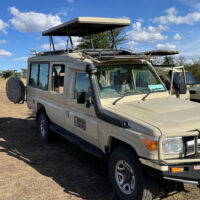Plan for Climbing Kilimanjaro, in 12 Steps
03.12.2010
To many, planning a climb up Mt. Kilimanjaro seems like such a daunting task, with countless details and variables to consider. Each of us has a unique way we go about planning a trip, but Embark has developed a checklist of the most important highlights with planning an expedition to climb Africa’s highest mountain. Read and consider these tips carefully; most of the details are common sense, but can be easily overlooked.
1. Make A Mental Commitment
It’s too easy to start down the path toward an enormous, life-changing adventure, and then give up in the preparation stage due to logistics, cost, conditioning, family reaction, etc. For most people, climbing Kilimanjaro is a once-in-a-lifetime opportunity. If you make the commitment, even if it’s not going to happen until next year, stick to it and make sure you will follow through. You do not want to be plagued by regret or resentment for not putting all the pieces together to make it happen.
2. Begin Your Training
This is the central and probably most important aspect for climbing any mountain in the world. Start your training early. In fact, the earlier you start, the better. Try to start training at least six months in advance, in order to ensure the highest probability of success, even if this just means short jogs or climbing stairs in the beginning of your regimen. Embark has a training program for you to use prior to your climb up Africa’s highest mountain.
3. Save
Traveling half way around the world and spending 7 to 10 days climbing a mountain can be expensive. Make sure to start saving as early as possible. Including gear, airfare, and the climb itself, the trip can easily range from $4,000 to $8,000 per person.
4. Find Others Looking For a Challenge
It’s always exciting to include others in your adventures, as it build strong relationships, it holds you to your word, and it gives you someone to train with. Since climbing Kilimanjaro can be done by just about anyone (those who take their time), you should consider bringing friends, family, and others interested in an adventure of a lifetime. Just make sure the people you bring are people you can cope with under sometimes demanding conditions.
5. Pick Your Outfitter and Guide
Whether you choose to pick your outfitter when you arrive or in advance, it’s important to establish a relationship with someone early that can get your climb up Kilimanjaro organized. You should start having conversations with the outfitter 8 to 12 months in advance, as it gives them plenty of time to organize guides, logistics, permits, etc. There are times in the year that are busy (Feb & Aug) and sometimes the best guides are booked a year in advance. The earlier you book, the better.
6. Determine Your Dates/Routes
After you pick your outfitter, you should start to determine the following: dates, number of people, routes, and other important aspects of your adventure. You will need to make sure you choose the proper route up Kilimanjaro, as well as the right time of year. For example, you would not want to plan a trip during the rainy season (April & May), unless you don’t mind walking in the rain all day, ever day. Likewise, in terms of the climbing routes, an experienced mountaineer, or someone who likes a little adventure, would most likely do the Lemosho or Machame Route, with an option up the Western Breach, instead of going up the Marangu Route.
7. Keep Training
Again, the central point for a successful trip is training, training, training. However you choose to prepare, be sure you are consistent with your training program.
8. Purchase Your Airfare
Once your dates and outfitter is finalized, it’s time to sure your flights. It’s best to shop around, as you can find huge price variations. You will want to purchase your airfare 3 to 7 months in advance. Make sure to check alternative, non-US-based carriers such as Ethiopian Airlines or Qatar Airlines if you want to keep the prices low.
9. Get Your Immunizations
Talk to you local travel clinic about 4 to 6 months prior to your trip. This will be the time you decide which immunizations you should get. Make sure to plan this into your budget, as sometimes these shots can be a significant addition.
10. Prepare Your Gear
Test all your equipment in advance. Try your new boots and jacket. Determine if you like to use Nalgene bottle or a Camel back for your water. All of your equipment should be tested and used as much as possible in advance.
11. Organize Your Visas
As of the time of this writing, you could get your visa upon arrival at the Tanzania airport, or at any border crossing. If you don’t want to deal with the hassle of organizing your visas upon arrival, you can get these sorted at the Tanzanian embassy in Washington, DC. Expect to take about 3 weeks to get your passport back.
12. Departure
The day has come. Say goodbye to your friends and family, and take off on your adventure!



